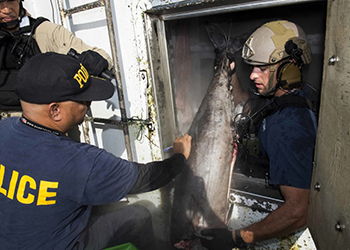The Coast Guard and Navy completed a 40-day joint mission in the Central and South Pacific under the Oceania Maritime Security Initiative to combat transnational crimes, enforce fisheries laws and enhance regional security this week.
A Coast Guard law enforcement detachment conducted 20 fisheries enforcement boardings with the assistance of the Navy's Visit, Board, Search and Seizure team and enforcement shipriders from the Federated States of Micronesia and Palau.
A Palauan law enforcement official and a Sailor assigned to the guided-missile destroyer USS Spruance inspect a foreign fishing vessel as part of Oceania Maritime Security Initiative. Petty Officer 3rd Class William Gaskill/Navy photo."OMSI demonstrates the ability to partner with not only military agencies, but local agencies," said Cmdr. Manuel Hernandez, commanding officer, Spruance. "The ability to leverage the unique capacity and capabilities of the U.S. Navy, the U.S. Coast Guard and their experience in law enforcement, USDAO, Foreign Fisheries Agency, and our partner nations in the area in support of the security and stability, and therefore the prosperity of the Asia-Pacific region is incredible."
Ten of the boardings were conducted on the high seas under the Western and Central Pacific Fisheries Commission guidelines, with one potential violation for tampering with a vessel monitoring system found. The other 10 were conducted in the Federated States of Micronesia and Palau exclusive economic zones, with three violations of improper logging of catch and one violation for lack of a bait fishing permit found.
"As captain of this ship, I am absolutely proud of the achievements, the success and the proficiency of this war fighting ship called Spruance," said Hernandez. "Not only from the tangible aspect of conducting 20 boardings, but also in strengthening our strategic partnerships in the area."
Boarding teams inspected documentation and fish holds for illegal activity and compliance with conservation and management measures. Coast Guard teams and Pacific Island Nation shipriders routinely conduct joint boardings within the host country's exclusive economic zones to protect the ocean and the living marine resources within.
"Illegal, unreported and unregulated fishing undermines efforts to conserve and manage global fish stocks," said Coast Guard Cmdr. Richard Howes, chief of enforcement, Coast Guard 14th District response division. "The OMSI mission along with our partnerships with Australia, New Zealand, France, and Pacific Island Nations helps deter illegal fishing and promote economic and environmental stability in the region."
The Coast Guard is responsible for patrolling the waters around the numerous islands associated with the United States throughout the region. Each of these islands has territorial waters stretching out to 12 nautical miles from shore.
Beyond that, stretching out to 200 nautical miles is an exclusive economic zone, an area defined by international law that allows each nation exclusive rights to the exploration and use of the marine resources within. Oceania contains 43 percent, or approximately 1.3 million square miles, of United States' EEZs.
The Spruance is an Arleigh-Burke class guided missile destroyer with a crew of 260 officers and enlisted homeported in San Diego. Spruance is deployed as part of a U.S. 3rd Fleet Pacific Surface Action Group (PAC SAG) under Commander, Destroyer Squadron 31 (CDS 31).







